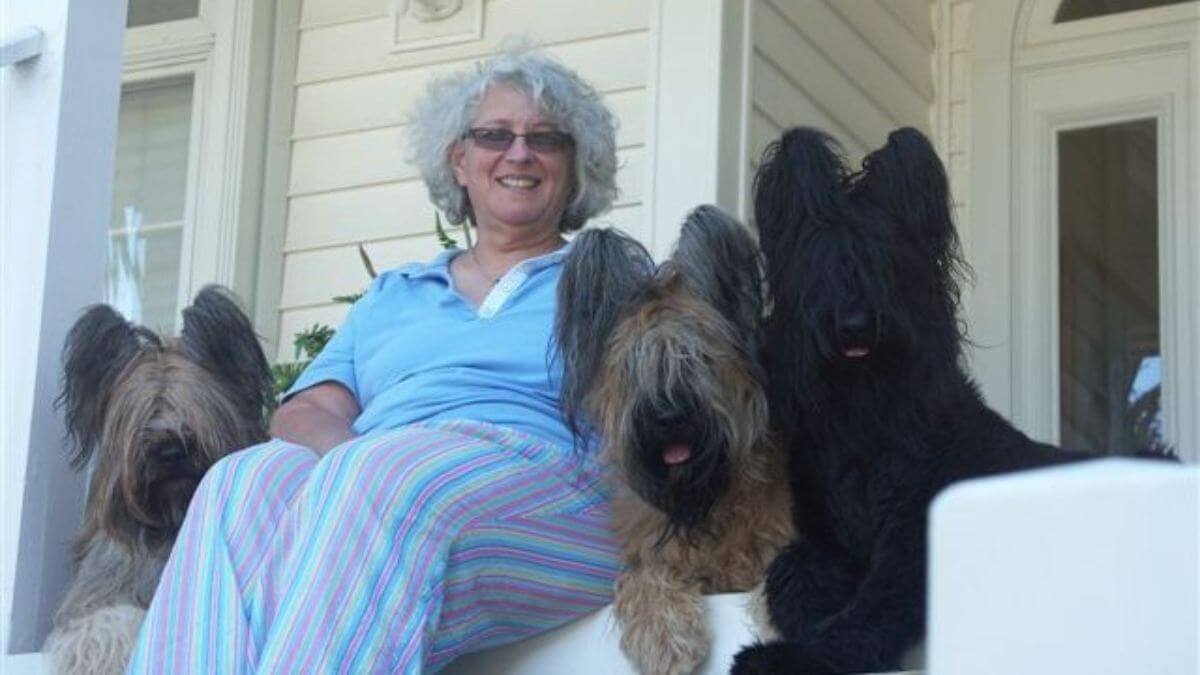


Home » Terry Miller & Dominique Dube | Déjà vu & Popsakadoo

Terry Miller & Dominique Dube
1. My partner, Dominique Dube, and I live in Novelty, Ohio, which is a countrified eastern suburb of Cleveland, Ohio. Dominique started in dogs when she was 15, growing up in Montreal. I graduated from college in the late 1970s, moved from where I attended college in Philadelphia, to Cleveland, for my dream profession of dog behavior and dog training, which had absolutely nothing to do with my education. I started mostly through my profession, competing in performance events (which were far fewer than what we have available now). I helped to start a Schutzhund club and competed in Obedience with my Standard Poodle. I had two clients with difficult Briards, which piqued my interest in the breed. I showed one of the two in Conformation for the client, who had little control over her dog. That immediately sparked my fascination with not only Conformation but in the Briard breed. That was around 1978.
I bought my first Briard in 1982 from Mary Lou Tingley of Phydeaux fame. Meanwhile, Domnjique was in law school in Montreal, beginning to show her family’s Briard. Ironically, Dominique and I met in 1985, buying bitches from Regina Keiter Sr., the mother of the very same Regina Keiter who shows our dogs now. I bred my first litter of Briards in 1985. My kennel name is Déjà vu; Dominique’s kennel name is Popsakadoo. We use both kennel names now on all of our puppies.
2. Like with anything that incorporates both Mother Nature and human intervention, the risks and rewards rely on luck, knowledge, and good judgement. Even though most of us complain about the increasing failure of breed quality, I suspect the more accurate truth waxes and wanes over time. Briards are in good shape health-wise, and pretty much always have been in my 42 years in the breed. Temperaments have always been a challenge, but I do believe temperaments have continued to improve. I think most conscientious breeders have become less tolerant of problematic temperaments; learned to make fewer excuses for poor behavior and have become much better managers of behavior and raising. So, I suspect as with all living creatures, it is a blending of nurture and nature.
One particular challenge that we have in Briards is the absence of breeders. So many of our Briard breeding community has vanished through lack of interest, natural attrition, or plain walking away. We have never had high numbers, which is probably a good thing since Briards can be temperamentally complex and absolutely not for everyone. At last count, we probably only have around 5 or 6 actively engaged in a dedicated breeding program (in
the US).
3. The number of shows seems to be diminishing. I think that this is much about clubs not being able to sustain the work and effort of holding up the sport for lack of workers/members. We are seeing so much of this in my area. I am involved in two clubs which have existed for decades and decades and carry with them so much history and contribution to the sport. We have difficulty simply finding enough people to work at putting on a dog show or represent the sport within our community. Dominique and I worry about who will inherit the sport. Who is coming up to take our places and fill the roles of stewardship to the sport and the dogs?
As far as judges… who are they? I look at panels or go to shows with judges I have never laid eyes on, or in many cases, never even heard of. Some are even from my own area in my own Group… but no one knows them and they have no or little footprint in the sport or even their own breed. How is it that we discover them after they are approved to judge half of our Group… or the entire Group?
4. For our breed, a general-purpose working farm breed, they love to do stuff and engage with pretty much any of the performance offerings. Briards live for Agilty, Fast CAT, Herding, Farm Dog, Carting, Dock Diving, or even more sedentary activities like Therapy Dogs in hospitals and nursing homes. Quite a few of the dogs we’ve bred compete in Agility passionately. The dogs are crazy for it and so are the owners.
5. The question is: Is social media good for anyone or at all? My opinion changes with the moment. I enjoy some of the perks of educational opportunities at times, but I am disturbed by the tribalism and lack of accountability.
6. The challenges are the same as we have in the world around us, since the dog community is nothing more than a microcosm of the larger world. The tribalism and predatory behavior is ugly and poisons the water for all. My fear for the dog community is the absence of people coming up with sound mentoring and dedicated devotion to keeping our sometimes-crazy dog world alive. Who will take the baton? As a breeder, my worry for my breed hangs huge over my feelings of stewardship and responsibility. Mary Lou Tingley was one of my most important mentors and one of my most cherished friends. Her example of true altruistic devotion to the Briard set a critical example and had a permeating influence on the culture of our breed throughout her life. She is gone and so is that irreplaceable presence.